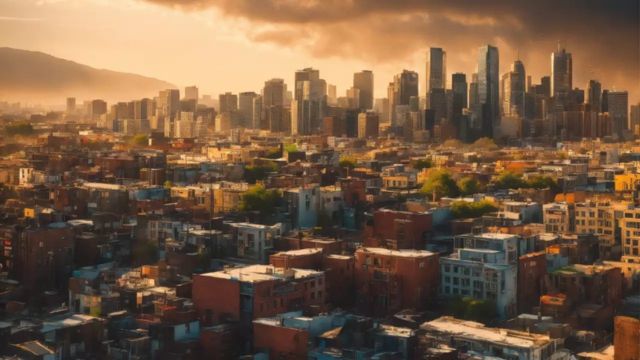MJP –
In a recent report, two California cities have been named among the “dirtiest” urban areas in America, drawing attention to the ongoing challenges of urban cleanliness and environmental management in the state’s largest metropolitan regions.
While California is known for its beautiful landscapes and progressive environmental policies, some of its cities are facing significant hurdles when it comes to maintaining clean and livable urban spaces.
A Grim Ranking: California’s Dirty Duo
The report, compiled by a national cleaning services company and based on various factors including pollution, waste management, street cleanliness, and litter levels, listed several major U.S. cities among the “dirtiest.” Two California cities—Los Angeles and San Francisco—earned spots on this unwelcome list.
While both cities are renowned for their economic power, cultural influence, and iconic landmarks, they have also been grappling with serious environmental and cleanliness issues in recent years. Here’s a deeper dive into the contributing factors that led to their inclusion on the list.
Los Angeles: A Struggle with Litter and Homelessness

Los Angeles, California’s largest city, has long been a focal point for debates on urban cleanliness. Despite ongoing efforts to improve street cleanliness, the city continues to struggle with high levels of litter, especially in highly trafficked areas like downtown Los Angeles, Venice Beach, and parts of Hollywood.
The report highlighted the city’s reliance on public waste management systems, which often fail to keep up with the massive volume of trash generated by its population of nearly 4 million residents.
One of the most significant challenges LA faces is homelessness. The city has one of the largest homeless populations in the U.S., with thousands of people living on the streets. The issue of encampments has become a central point of concern for both residents and city officials. The homeless crisis contributes to trash and waste piling up in public spaces, and cleaning these areas is often difficult due to the need to respect residents’ rights while addressing sanitation.
2 Upstate New York Cities Named Among America’s Best Small Towns
Additionally, the city’s high levels of vehicle traffic contribute to air pollution, and parts of Los Angeles are dealing with a combination of smog and uncollected litter, which only worsens the perception of the city’s cleanliness.
Despite efforts like the “LA Sanitation” department’s curbside cleaning programs and the “Litter-Free LA” initiative, public opinion remains divided on whether these efforts are enough to turn the tide.
San Francisco: A Growing Waste Management Crisis
San Francisco, another California powerhouse, has also found itself on the list of America’s dirtiest cities. Once lauded as one of the cleanest cities in the country, the Bay Area city has faced mounting challenges in recent years. The key issues affecting San Francisco’s cleanliness are related to waste management, homelessness, and increasing tourism.
San Francisco has one of the highest rates of homelessness in the nation, with tent encampments and public drug use becoming increasingly visible in neighborhoods like Tenderloin, Mission District, and South of Market (SoMa). These areas are also the hardest hit by litter and waste problems. While the city is known for its environmentally conscious initiatives—such as its extensive recycling programs and “zero waste” goals—those efforts have not been enough to keep public spaces free of trash and waste, especially in the wake of a booming homeless population.
Reports from local sanitation workers and community members point to overflowing public trash bins, particularly in popular tourist spots like Fisherman’s Wharf, Chinatown, and Golden Gate Park. While the city has made attempts to address these issues, such as increasing street cleaning services and implementing more frequent garbage pickups, these solutions have not fully alleviated the cleanliness problems.
In addition to the homelessness issue, the city’s high cost of living, coupled with overcrowded public transit systems, has contributed to a rising sense of frustration among residents. San Francisco residents have voiced concerns about the safety and cleanliness of their neighborhoods, which impacts the city’s overall reputation.
What’s Being Done to Address the Issue?
Both Los Angeles and San Francisco are actively working to combat these cleanliness issues, but the scale of the problem requires significant resources and long-term planning.
California Dreamin’ Are 18 Cities Ranked for Their Kindness—Is Yours on the List?
In Los Angeles, Mayor Karen Bass’s administration has pledged to tackle homelessness more effectively, with a focus on building more housing and expanding outreach services to those living on the streets. Additionally, LA’s sanitation department has ramped up efforts to clean public spaces and prevent littering through public education campaigns and increased enforcement of littering laws.
San Francisco has also taken action with Mayor London Breed’s focus on expanding housing initiatives and enhancing the city’s street cleaning efforts. In recent years, the city has implemented a new public cleanliness initiative called “Clean San Francisco,” which includes expanding outreach programs for homeless residents and deploying more street cleaning teams. Still, the city faces resistance from residents who argue that these measures have not made a visible difference.
Both cities are also working to increase their recycling and waste diversion programs, focusing on reducing waste sent to landfills, while continuing to address the systemic issues contributing to the urban decay.
The Bigger Picture: The Growing Strain on Urban Infrastructure
At the heart of the cleanliness issues in these two cities lies the broader challenge of urban infrastructure. California’s major cities, like Los Angeles and San Francisco, have been growing rapidly in recent decades, placing unprecedented stress on their infrastructure and public services. Aging systems, a shortage of affordable housing, and underfunded services have led to a situation where it can be difficult to keep up with the rising demands of urban living.
Homelessness, in particular, has emerged as a pressing issue that many cities across the country, including in California, are struggling to address. The visible impact of homelessness on public spaces—combined with inadequate waste disposal, litter, and trash removal—is a serious issue for urban areas trying to maintain their image and livability.
Conclusion: The Road Ahead for California’s ‘Dirtiest’ Cities
While Los Angeles and San Francisco are facing difficult challenges when it comes to cleanliness, it’s important to recognize that these issues are not unique to California. Many cities around the United States are grappling with similar concerns, and finding sustainable solutions will require coordinated efforts between local governments, businesses, and communities.
As these two iconic cities continue to deal with these issues, it remains to be seen whether their progressive policies can overcome the growing pressures of urban life, or if they will remain a glaring example of the difficulty in managing modern metropolises. For now, they are focusing on practical solutions, hoping that with continued effort, they can clean up their image and restore their cities to the level of cleanliness their residents expect.




